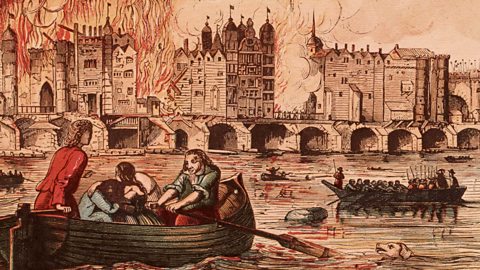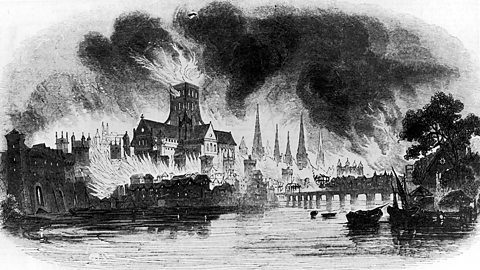Synopsis: 'Welcome to MATRIX!'
Kerry welcomes the listeners to ÔÇśMatrixÔÇÖ - the Museum of Advanced Technological Realisation and Interactive Exchange - or Matrix for short! She explains to the listeners that they are here today to help the museum try out a new virtual reality exhibition about the Great Fire of London. Soon they will put on virtual reality helmets and be transported back to the sights and sounds of 1666. First though, Kerry plays the children a short recording to begin their visit: as they move around London in 1666, looking for safety, they must undertake three challenges: i) they must offer help if asked along the way; ii) they must return something that has been lost; iii) they must speak with a king.
Then the children don their ÔÇśVRÔÇÖ helmets and are transported back to London at the time of the Great Fire. First they must escape from their own home, which is in danger of catching fire. Following that the children travel towards the River Thames in the hope of getting across. They are stopped in the street and must help to tackle the fire, using a human chain of buckets. Later the children try to persuade the ferryman to take them across the river - but with no joy. Before returning to Matrix and the modern day the group resolves to head to higher ground to the north of the city boundary.
Using these drama programmes
The two 15ÔÇÖ minute programmes in this unit explore The Great Fire through classroom drama activities. The programmes are set in an interactive museum and the children remain in role throughout as visitors to the museum, helping to test a new interactive exhibition about the Great Fire of London. At various points through the programme our guide - Kerry - asks the group to come together and offer her suggestions. Be ready at these points to pause the programme and assume the role of Kerry yourself if you feel it will aid the quality of childrenÔÇÖs work.
The programmes aim to:
- develop imagination and creative responses
- provide opportunities for careful, focused listening using a range of voices and a variety of styles
- enable children to see issues and dilemmas from a number of points of view
- build pupilsÔÇÖ confidence in drama, gradually introducing more complex tasks
- engage pupils in drama activities involving discussion, sharing of ideas, co-operation, planning and presentation of responses to other members of the class
- provide opportunities for ÔÇśteacher in roleÔÇÖ to extend pupilsÔÇÖ vocabulary, speaking skills and imagination
- offer a flexible cross-curricular resource, meeting drama and other subject goals
Before the programme:
- listen to the programme and read through these notes in advance to assess suitability and note areas for development or extra support
- use the best equipment available ÔÇô it makes a real difference to the childrenÔÇÖs concentration and work
- you will need a fairly large, cleared space and about 40 minutes to complete the work for each programme
During the programme refer to these Notes which provide:
- brief synopsis of the story
- the programme structure - the activities that will take place during the programme
- teacher guidance - ideas for teacher involvement intended to get the most out of the programmes
- short, dramatised scenes with a narrator - these set the scene and give instructions
- sections of background sound effects - these provide a stimulus for pupil activities

╠ř
╠ř
Play next
6. Put the Fire out! audio
The final programme exploring The Great Fire of London through dance activities.

8. Completing the challenge. audio
Part 2 of a two-part interactive role play adventure about The Great Fire of London.

9. The story of The Great Fire of London. audio
Cat Sandion looks back to 1666 and causes and consequences of The Great Fire of London.
